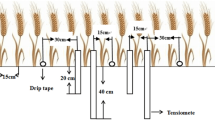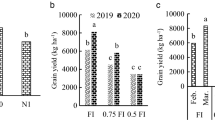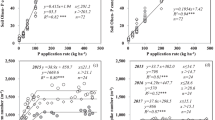Abstract
A WATER shortage at any stage of plant growth usually results in a reduction in vegetative growth, but many annual crop plants are especially sensitive to changes in soil moisture conditions during the period from flower initiation to the development of full flower1–3. It has been shown that during this period shortage of water has a maximum depressive effect, and irrigation has a maximum beneficial effect, on the yield of seed and fruit. Pea plants (Pisum sativum L.) respond in this manner, and while soil moisture conditions during the period from sowing until the start of flowering have little influence on final yield of peas1,4, this crop is particularly responsive to irrigation at the start of, or during, flowering1,4–6. Later, at the flat-pod stage of growth, the plants again appear to be insensitive to soil moisture conditions, but they respond to irrigation when the pods are swelling4. Both Mühleisen7 and Salter4 have analysed the effects of irrigation at flowering on the components of yield and demonstrated that the increase in yield occurred through an increase in the number of seeds set per pod and pods set per plant. The reasons why plants should be so sensitive to soil moisture conditions during flowering, however, have not been satisfactorily determined. Brouwer1,5 suggested that the beneficial effect of irrigation at flowering arose from the increased availability of nutrients brought about by the increased water supply.
This is a preview of subscription content, access via your institution
Access options
Subscribe to this journal
Receive 51 print issues and online access
$199.00 per year
only $3.90 per issue
Buy this article
- Purchase on Springer Link
- Instant access to full article PDF
Prices may be subject to local taxes which are calculated during checkout
Similar content being viewed by others
References
Brouwer, W., Die Feld Beregnung, fourth ed. (DLG-Verlag, Frankfurt/Main, 1959).
Skazkin, F. D., Timiryazevskie chteniya AN SSSR, 21, 1 (1961).
Salter, P. J., and Goode, J. E., Res. Rev., Bur. Hort. E. Malling, 1, 1 (1965). (In the press.)
Salter, P. J., J. Hort. Sci., 38, 321 (1963).
Brouwer, W., Z. Acker-u. PflB., 91, 319 (1949).
Schendel, U., Z. PflErnähr. Dung., 59, 27 (1952).
Mühleisen, R., Z. Acker-u. PflB., 94, 59 (1951).
Marshall, T. J., Tech. Commun. Commonw. Bur. Soils, 50, 1 (1959).
Loehwing, W. F., Science, 92, 517 (1940).
Leonard, E. R., Bot. Rev., 28, 353 (1962).
Author information
Authors and Affiliations
Rights and permissions
About this article
Cite this article
SALTER, P., DREW, D. Root Growth as a Factor in the Response of Pisum sativum L. to Irrigation. Nature 206, 1063–1064 (1965). https://doi.org/10.1038/2061063b0
Issue Date:
DOI: https://doi.org/10.1038/2061063b0
This article is cited by
-
Effect of Sowing Date and Cultivar on Root System Development in Pea (Pisum sativum L.)
Plant and Soil (2006)
-
Seasonal patterns of growth and nitrogen fixation in field-grown pea
Plant and Soil (1987)
-
Moisture stress in navy beans
Irrigation Science (1980)
-
The effect of irrigation on the length, weight, and diameter of lettuce roots
Plant and Soil (1974)
-
Mineral nutrition and the water relations of plants
Plant and Soil (1967)
Comments
By submitting a comment you agree to abide by our Terms and Community Guidelines. If you find something abusive or that does not comply with our terms or guidelines please flag it as inappropriate.



